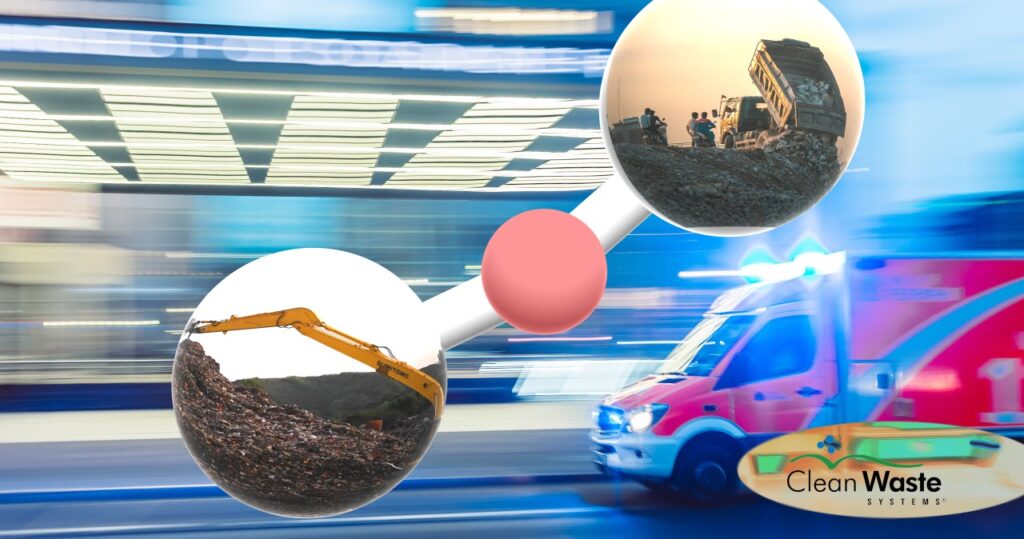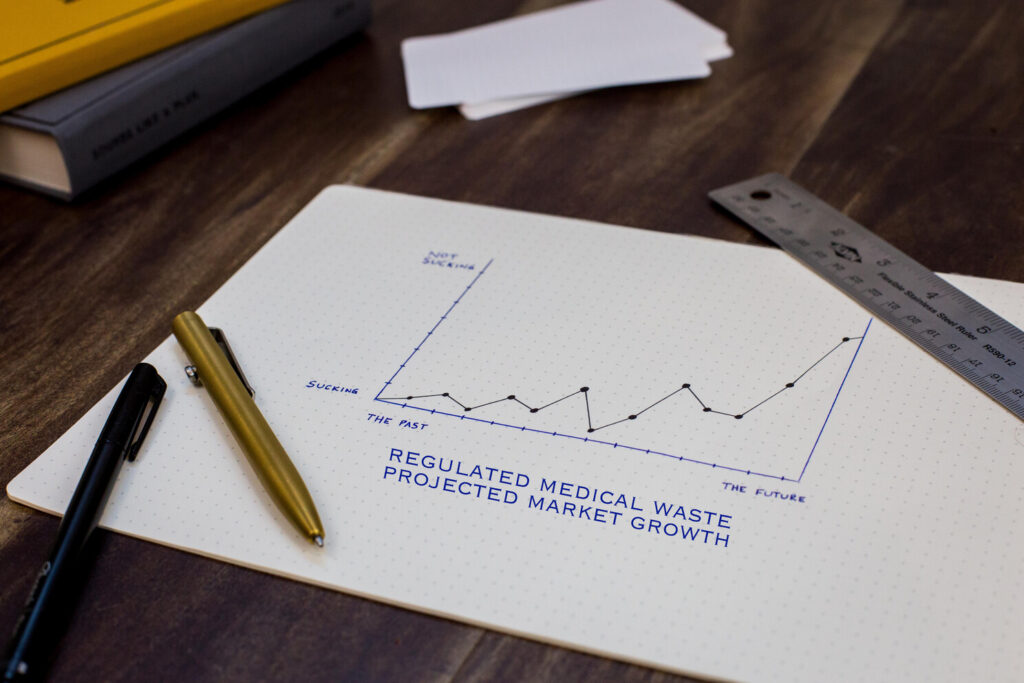From, The Clean Waste Systems newsletter. Read original article HERE:
Clean Waste Systems manufactures medical waste disposal systems using ozone. This provides a cleaner, greener solution to medical waste processing. For more info on the use of ozone for medical waste disinfection and disposal contact Clean Waste Systems today for a better solution for medical waste disposal.

With healthcare organizations around the globe pledging to decarbonize the healthcare sector, if your organization hasn’t, now’s a great time to begin exploring zero-emission technologies. The Ozone Medical Waste (OMW) Treatment System provides a unique differentiator in medical waste treatment and disposal.
As stewards of the Earth, we’ve spent years developing a system designed for longevity. Autoclaves, microwaves, and incinerators are all key players in medical waste treatment and disposal strategies. Providing a decent option to sterilize and slightly reduce waste volume, however, the pitfalls of these tradition methods tend to negatively impact our environment. From continuous trips to the landfill, low-efficacy disinfection, air pollutants, and more, the environmental costs associated with these methods begin to compound.
The OMW Treatment System is reshaping how we handle multiple medical waste streams. Instead of having countless vendors aiding a health system in managing multiple types of medical waste, our system provides an all-in-one solution controlled by the organization.
You control the number of trips to the landfill, drastically reducing Scope 3 emissions (for a refresher on emission scopes, click here). With those mentioned above, the traditional methods, Scope 3 emissions are challenging to quantify due to the innumerable trips of waste to processing plants and then to landfills. Also, health systems are dependent on vendor reporting for accurate emissions assumptions, leading to inaccuracies across the board — a faith-based system vs. an evidence-backed one.
Additionally, methane emissions at the landfill need to be of concern. According to the EPA, “when MSW is first deposited in a landfill, it undergoes an aerobic (with oxygen) decomposition stage when little methane is generated. Then, typically within less than one year, anaerobic conditions are established, and methane-producing bacteria begin to decompose the waste and generate methane.” With the Inflation Reduction Act (IRA) signed into law, organizations that can reduce their methane emissions can receive financial benefits.
The OMW Treatment System uses heavy-duty industrial shredders to break apart and reduce waste volume by up to 90%, rendering it unrecognizable, almost like confetti. Once shredded, it is exposed to our highly effective Humidizone™️. This formula is ozone with moisture for complete sterilization and odor reduction.
It achieves higher levels of disinfection than traditional methods, protecting environments surrounding landfills, and ensuring worker safety from exposure to hazardoous waste or toxins in the air on the back end of the operation. The only emission from our system is oxygen, a far cry from acid gases, heavy metals, persistent organic pollutants (dioxins/furans), and nitrogen oxide byproducts of incineration and the harmful remnants of autoclave treatment.
Contrary to incineration and autoclaving, our system requires far less energy, less water, and less effort to work effectively. We are positioning the OMW Treatment System as a stand-alone opportunity for an on-site, financially responsible medical waste treatment option for hospital clinics and large-scale health systems decarbonize their waste streams.
Projected Market Growth of the Medical Waste Industry

The medical waste management market has been booming since the pandemic, primarily a derivative of the tremendous amount of medical waste generated. However, the lucrative projections of this industry also contribute to the gold rush mentality. The global medical waste management market size was valued at $7,226.4 million in 2020, and is projected to reach 12,834.9 million by 2030.[1]
The industry is broken into various segments such as service, type of waste, treatment location, and region, then broken down further into smaller, more specified parts.
- Service – collection, storage, transportation, treatment and disposal, recycling. Treatment and disposal consists of microwaving, autoclaving, incineration, and chemical treatment.
- Type of Waste – non-hazardous and hazardous. Hazardous being infectious and pathological, sharps, pharmaceuticals, red bag, chemo, etc.
- Treatment Location – on-site or off-site.
The most dominant segment for 2020 was treatment and disposal services, and “is expected to continue this trend during the forecast period, owing to increased demand for incineration, rise in prevalence of chronic disease, and advancements in technology for medical waste treatment.” (Medical Waste Management Market Size, Share, Report 2030, n.d.)[1]
However, the same report projects that transportation and storage services will experience growth due to the projected increase in the volume of waste. Also, off-site treatment dominated the market in 2020 and is expected to continue, which is an alarming trend if we consider the environmental and financial burden of most of these practices.
Looking toward the future, we must prioritize better on-site treatment technologies while focusing on fewer collections and transports. At Clean Waste Systems, we consider these projected trends “business as usual,” which is how we got into this waste mess in the first place.
Better solutions exist right now that can reduce waste volume, sterilize with extremely high efficacy, eliminate many trips to the landfill (or to your service provider’s location of treatment), produce zero emissions, and more. The market projections don’t yet consider these solutions due to the traditional mindset that is entrenched in healthcare.
With Clean Waste Systems, healthcare executives can eliminate outsourced medical waste services entirely, freeing up some capital to put back into other modalities of their system. Additionally, it will be a significant first step in the route to net zero while affording your organization more flexibility, more control, and better results for your surrounding communities.
Burn Baby, Burn

With incineration practices projected to ramp up over the next ten years, let’s think a little deeper and identify why this method should go extinct within the healthcare community. Across the globe, healthcare systems have been pledging to “get to net zero” or “decarbonize,” while their waste streams continuously go to burn pits or incineration plants.
While many reports account for the positive and “green” aspects of incineration, these claims are difficult to quantify and have logical fallacies.
For example, if waste to energy continues to be touted as a renewable source of energy, some problems arise. First, wouldn’t we rely on waste for us to have power? What kind of carbon emissions are produced during the burn? How many pounds of waste can incinerators handle per hour? What safeguards are in place to reduce the toxins released?
These are just starter questions. According to a report from Eunomia, “increasing proportions of hard-to-recycle plastic waste sent to incinerators will increase the carbon impacts of incineration. Plastic is derived from crude oil and the carbon is released when burnt. So, while the electricity grid should be decarbonizing as a result of more renewable energy sources coming online, electricity produced at the incinerator will become a major climate issue.” (The Environmental Impacts of Waste Incineration, 2021)[2]
As the amount of waste sent to incinerators increases, the number of toxins released into the air will additionally increase, potentially harming the local communities surrounding burn locations.
Furthermore, if we are to embody the ethos of “reduce, reuse, and recycle,” relying on incineration curbs this desire. We won’t be able to recycle as much, contrary to autoclave sterilization and disposal (not the best, but better than incineration), which will encourage our society to continue to produce excess goods out of “new” materials.
To truly make a change, thinking outside the box is necessary. Taking a step back, observing the logic behind traditional and proposed methods, and then testing these ideas carefully with a comprehensive analysis of these methods’ environmental, societal, and organizational impacts is detrimental.
Start digging into ideas like waste to energy or incineration as a viable solution to the waste issue, and you’ll find that these ideas are Swiss cheese.
References
[1] Medical Waste Management Market Size, Share, Report 2030. (n.d.). Allied Market Research. Retrieved September 14, 2022, from https://www.alliedmarketresearch.com/medical-waste-management-market
[2] The Environmental Impacts of Waste Incineration. (2021, October 18). ClientEarth. Retrieved September 14, 2022, from https://www.clientearth.org/latest/latest-updates/stories/the-environmental-impacts-of-waste-incineration/
